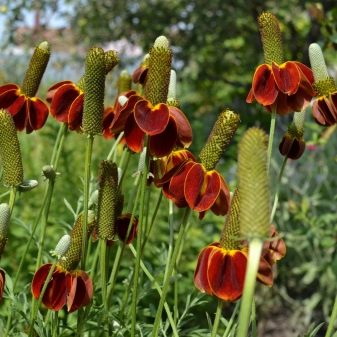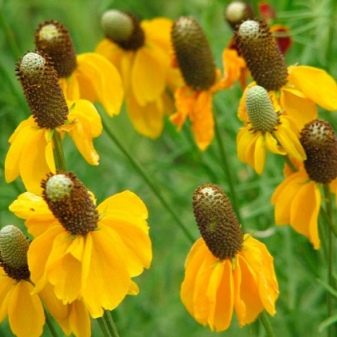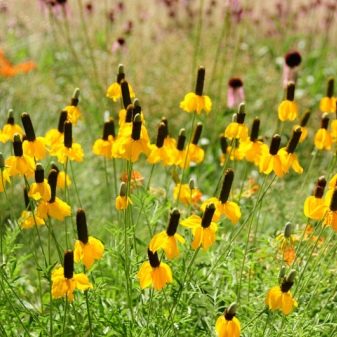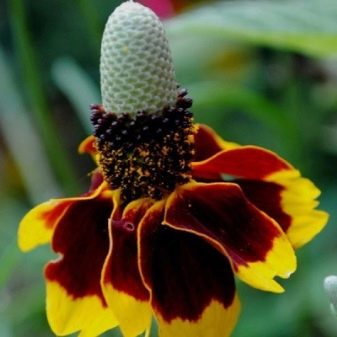All about ratibid

After reading this article, you can learn everything about ratibid columnar and other types of flowers. Planting and caring for this plant deserve attention. Growing from seed outdoors must be organized very carefully.


Description
It should be pointed out from the outset that ratibida is a unique flower. Under this name, a large and actively flowering plant appears, giving inflorescences of a spectacular appearance. It is believed that the ratibid comes from North America. It is found from the Canadian to the Mexican border at least. However, even in the conditions of Russia, it will not be difficult to grow it. The earliest information about ratibid appeared at the beginning of the 19th century. They were associated with expeditions to the Great Plains. Its alternative names, "Mexican hat" or "sombrero", the plant received due to the visual similarity with such a headdress.
This specificity, in turn, is provided by a very convex central part, which has a bright border of yellow or burgundy petals. The perennial variety "Velvet collar" is also quite well known in Russia. The stems of the ratibids grow straight. They give only a small number of branches. Small leaves develop on the stems, visually resembling a lancet. Such foliage is green. It comes in both dark green and silvery tints. The plant thrives in both dry, dry areas and cool areas.


Types and varieties
Ratibide cannot boast of a special botanical diversity. The most common is the columnar variety. Conflover. Its popularity is largely due to the large size of the flowers. Section - 80-100 mm. The length of the stems sometimes reaches 1000 mm (that is, 1 m). Ratibida "Beautiful" has petals of 2 colors. In the center, they have a crimson red tone. There is a yellow section along the edge. This contrast is precisely the main characteristic of the flower. It provides originality and a spectacular look.
The Cheyenne Yellow type has extremely delicate petals. They are colored in a delicate yellow tone. In addition to the non-standard color, such petals also have a non-standard geometric shape. Midnight Red is distinguished by purple petals, mixed with a burgundy hue. There is also a subtype "Prairie Flower", which:
- gives erect stems;
- has hanging bright yellow petals;
- attracts a large number of pollinating butterflies;
- blooms from July to October;
- grows to 0.6-0.7 m;
- mainly cultivated in the Moscow region for lawn decoration.
Ratibida pinnate no longer has a cylindrical, but an expanded core. This part is slightly flattened. The petals are relatively narrow. They are colored yellow and have an aniseed aroma. The height can reach 100-120 cm.
Among this plant, there are such subtypes as:
- var. Pulcherrima, characterized by a wine-red tint of the main part of the petals and a yellow edging;
- Red Midnightgiving dark red flowers.


Planting and leaving
In order for the ratibid to please with its appearance, planting and care activities must be carried out correctly.
Location
In regions with mild climates, ratibid can be grown directly in the open field. In the south of Russia, the necessary conditions are created in the last decade of February. In the middle lane, it is advisable to choose the right moment in March. The soil must be carefully dug and leveled.Spaces of 300 mm must be left between grooves 20 mm deep. When the seedlings begin to germinate, they will have to be thinned out. Ratibida needs good drainage. It cannot be grown where water stagnates. On garden plots, you need to choose sunny areas for it. As a last resort, the use of slightly shaded areas is allowed. Ratibida is actively planted in groups.
Such plantings are stylized as a meadow. Basically, they are exploring the territory along the tracks. The peculiarities of the structure of the bush and the rarity of the leaves do not allow using it as a single decoration. The plant's high hardiness means that it must be planted next to equally hardy crops. Excellent companions can be considered:
- rudbeckia;
- Clover;
- felt;
- pachisandra;
- chamomile;
- echinacea.

The soil
Exotic culture thrives on loams. These soils can be neutral or slightly alkaline. But still the plant is unpretentious. In principle, any soil will suit him, with the exception of extremely wet and acidified. Therefore, the close location of soil waters or reservoirs is categorically unacceptable.
Be sure to choose:
- loose soil;
- homogeneous land;
- areas devoid of lumps.

Watering
Irrigation of the flowerbed, where the ratibid grows, is almost not required. The only exceptions are the most problematic dry periods.... We must be guided by the state of the plants themselves and the land around them. Important: after active weeding, watering is still recommended. Waterlogged land is destructive for this species.
For work, they use water that has settled and warmed up under the sun's rays, and in wet weather, watering is not at all necessary, but loosening is required.

Top dressing
No fertilization is required for this plant. Excessive replenishment of nutrients leads to the growth of green parts. The flowering is not going as well as it should be. It is only necessary to add nutrient reagents on very poor soil or if the culture itself shows signs of depletion. Ratibida thrives on limestone-rich soil, clay and loam.

Reproduction
Growing from seed is moderately difficult. With due attention, it will definitely give a good result.... It is necessary to sow seeds in the first half of February. This approach allows you to achieve flowering by the end of summer. Planting material is harvested at the end of October and during November. At this point, the boxes are guaranteed to dry out and have a dark brown color. Before sowing seeds, they must be kept at a temperature of + 5-7 degrees for 30 days. This cold stratification is quite sufficient to activate the ratibid. It is necessary to sow seeds in moist substrates with a neutral acidity level. Landings are placed on illuminated windowsills at an air temperature of 20 to 25 degrees.
The choice of pots or boxes as capacity is at your discretion. Regardless of this covering with plastic wrap is recommended. Moisture will not escape through it, and at the same time, the greenhouse effect is maintained in this mode. In a couple of weeks, friendly shoots will come out. They will have to dive into separate containers when a pair of real leaves appears. When the seedlings get stronger, they are transferred to cool places or to greenhouses. They are kept there for 10 to 15 days until stable heat comes. Usually in mid-May, this crop is planted in open land. The space between plants is 200-250 mm.
In addition to the seed technique, you can resort to grafting. The development period of ratibid is 4 to 5 years. It is distinguished by abundant self-seeding. This allows for self-updating.
You can divide the bushes at the age of 2 or 3 years. Difficulties are associated with the core structure of the roots.


Use a transfer shovel whenever possible. This eliminates damage to the root itself. It is also helpful to keep more soil and roots around the ratibid. The seedling technique is preferable to dividing the bush in areas with a particularly difficult climate. The planting material that has passed cold stratification will need to be sown on a slightly damp substrate. The best substrate option includes equal proportions of peat, sand and sod land. Some perlite is sometimes added. It is not necessary to plant seeds in the soil, it is even harmful. Without sunlight, the sprouts are unlikely to show healthy growth. It is enough if the seeds are simply pressed to the ground.
Experts note the fragility of ratibide roots. Because of this, it is more correct to keep the culture from the very beginning not in common boxes, but in separate cups. The same reason makes it not very advisable to pick up until the transfer to the final place. This procedure is carried out only when absolutely necessary. In order for the ratibid to germinate and develop, it is required to exclude the temperature drop below +20 degrees. It is recommended to slightly moisten the soil in containers with seedlings from time to time as soon as it dries up. Every day, the film is slightly opened so that the plantings are aired and condensation does not accumulate. The emergence of early shoots indicates that everything is going well. The final planting area is prepared at the end of the previous growing season. Since autumn, the soil is carefully dug up. At this moment, 0.1 kg of wood ash is laid per 1 sq. m. On the same area, 10 kg of compost must be used. Additionally, a small amount of dolomite flour is used.
All this needs to be thoroughly loosened. Sometimes it is necessary to introduce sand and lime chips.

The last two components are important if the soil itself does not maintain good air and water permeability by default. Such substances will ensure their circulation. You can plant ratibida even where it is damp and the land is swampy. A brick fight or river pebbles of a large fraction are placed under such flower beds. This drainage is usually sufficient. Seed propagation in late autumn usually does not require additional preparation. They just prepare furrows in the soil and sow the planting material evenly. It needs to be sprinkled with a sandy layer and covered with coniferous paws. Returning to the seedling technique, it is worth emphasizing that the seedlings themselves need active diffused insolation. Approximately 14 days before transplanting the seedlings to their final place, they are hardened.
Do this daily in the fresh air. An ordinary balcony or a garden will do. However, in any case, the plants must be protected from being blown by drafts and from the effects of precipitation. The transplant should ideally take place in the evening. The procedure can also be carried out on a cloudy day. There should be no less than 25 cm between the holes. Planting seedlings with a soil ball (in a peat pot) helps to prevent damage to the root system. It must be remembered that the flowering of ratibide in the first year of development is rare. The exception is when it is very hot in August.
When growing a plant as a perennial, the bush in the spring months is taken out of the ground and divided into segments, planted in separate pits in another area. Violation of this rule threatens lignification of the shoots at the beginning of the growing season.


Diseases and pests
Ratibida is distinguished by decent immunity to pathologies and pests. However, it is likely to be affected by powdery mildew and fungal spotting. In such cases, fungicides are used. If the plant is infected with rot, it will have to be destroyed, and the ground is additionally disinfected. When powdery mildew appears, first use a weak solution of soda, and in advanced cases, fungicides. Harmful insects rarely attack ratibida, they fight them in the usual ways.









































































































The comment was sent successfully.